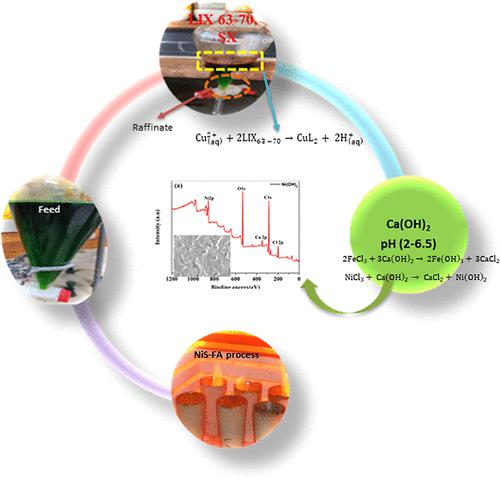Our official English website, www.x-mol.net, welcomes your
feedback! (Note: you will need to create a separate account there.)
Removal of Nickel from Nickel Sulfite-Fire Assay Dissolution Filtrate Through Precipitation
ACS Omega ( IF 3.7 ) Pub Date : 2024-01-25 , DOI: 10.1021/acsomega.3c07623 Happy Mothepane Mabowa 1, 2 , Andile Mkhohlakali 1 , Sam Mokoena 3 , James Tshilongo 1, 2 , Luke Chimuka 2
ACS Omega ( IF 3.7 ) Pub Date : 2024-01-25 , DOI: 10.1021/acsomega.3c07623 Happy Mothepane Mabowa 1, 2 , Andile Mkhohlakali 1 , Sam Mokoena 3 , James Tshilongo 1, 2 , Luke Chimuka 2
Affiliation

|
This study responds to stringent environmental regulations and increasing focus on resource conservation by exploring economically viable refining technologies through recycling. With the rising costs of filtrate disposal, there is a significant emphasis on removing and recycling valuable constituents, particularly nickel and copper (Ni and Cu). Herein, we employ analytical techniques with the aim of investigating an alternative method for recovering Ni and other valuable metals from a nickel sulfide-fire assay filtrate using S-curve precipitation under optimal conditions. The waste from the fire assay procedure contains substantial amounts of Ni and other critical metals, with concentrations of 62.7 g/L of Ni and 3.87 g/L of Cu. Prior to precipitation, traditional solvent extraction was used for Cu extraction, selectively removed before separating primary impurities such as iron (Fe). A pivotal aspect of this research involves applying S-curve precipitation with precise parameters at different pH levels. Analytical techniques reveal a minor depletion occurs as Ni is separated from Fe at a pH of 2.5, resulting in the formation of a refined Ni stream that is then refined into a mixed hydroxide Ni(OH)2 product. The efficiency of 5,8-diethyl-7-hydroxydodecan-6-oxime (LIX 63–70) in extracting value-added metals from fire assay waste is exceptionally high, integrating recycling and repurposing of value-added base metals to promote a circular economy.
中文翻译:

沉淀去除亚硫酸镍火法溶解滤液中的镍
这项研究通过回收利用探索经济上可行的精炼技术,响应严格的环境法规和对资源保护的日益关注。随着滤液处理成本的不断上升,人们非常重视去除和回收有价值的成分,特别是镍和铜(Ni 和 Cu)。在此,我们采用分析技术,旨在研究在最佳条件下使用S曲线沉淀从硫化镍火法滤液中回收镍和其他有价值金属的替代方法。火试金过程产生的废物含有大量镍和其他关键金属,镍浓度为 62.7 克/升,铜浓度为 3.87 克/升。在沉淀之前,使用传统的溶剂萃取法提取铜,在分离铁 (Fe) 等主要杂质之前选择性去除铜。这项研究的一个关键方面涉及在不同 pH 水平下应用具有精确参数的S曲线沉淀。分析技术表明,当 Ni 在 pH 值为 2.5 时与 Fe 分离时,会发生轻微的损耗,从而形成精炼的 Ni 流,然后将其精炼成混合氢氧化物 Ni(OH) 2产品。 5,8-二乙基-7-羟基十二烷-6-肟 (LIX 63–70) 从火试废中提取增值金属的效率非常高,整合了增值贱金属的回收和再利用,以促进循环利用经济。
更新日期:2024-01-25
中文翻译:

沉淀去除亚硫酸镍火法溶解滤液中的镍
这项研究通过回收利用探索经济上可行的精炼技术,响应严格的环境法规和对资源保护的日益关注。随着滤液处理成本的不断上升,人们非常重视去除和回收有价值的成分,特别是镍和铜(Ni 和 Cu)。在此,我们采用分析技术,旨在研究在最佳条件下使用S曲线沉淀从硫化镍火法滤液中回收镍和其他有价值金属的替代方法。火试金过程产生的废物含有大量镍和其他关键金属,镍浓度为 62.7 克/升,铜浓度为 3.87 克/升。在沉淀之前,使用传统的溶剂萃取法提取铜,在分离铁 (Fe) 等主要杂质之前选择性去除铜。这项研究的一个关键方面涉及在不同 pH 水平下应用具有精确参数的S曲线沉淀。分析技术表明,当 Ni 在 pH 值为 2.5 时与 Fe 分离时,会发生轻微的损耗,从而形成精炼的 Ni 流,然后将其精炼成混合氢氧化物 Ni(OH) 2产品。 5,8-二乙基-7-羟基十二烷-6-肟 (LIX 63–70) 从火试废中提取增值金属的效率非常高,整合了增值贱金属的回收和再利用,以促进循环利用经济。


















































 京公网安备 11010802027423号
京公网安备 11010802027423号